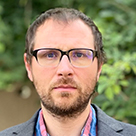Wide-field, Single-pixel Fluorescence Imaging with On-chip Nanophotonics
Project Summary
Quantifying molecular interactions within intact biological systems provides key insight into the spatiotemporal dynamics of biological regulation from single molecules up to the organism level. Out of the range of methodologies available to researchers, one of the most powerful is fluorescence microscopy. Fluorescent reporters can be used to label specific chemical species, molecules, or other structures. Rigorous quantification of fluorescent molecules requires precise delivery of incoherent or coherent excitation photons paired with detection of the relatively weak, incoherent emission photons that report on the location and concentration of the fluorescent emitter(s). The performance of common fluorescence microscopy approaches rapidly degrades in the presence of relatively weak aberrations, scattering, or absorption. This intrinsic tradeoff has led to a series of increasingly complex non-linear and adaptive methods to counteract the loss of quality in fluorescence microscopy at subcellular resolution in real-world samples.
This team aims to develop an aberration and scatter-resistant microscopy method by scaling down and replacing the physical optical imaging elements with a single nanophotonic chip that dynamically patterns the excitation light and a large format single-pixel detector to collect both scattered and unscattered fluorescence. By removing the physical optics, this team will decouple the light collection efficiency of the microscope from the process of creating a spatial correspondence between the excitation and emission photons. To achieve these goals, this team will combine wavefront shaping by nanophotonics with computational and fluorescence imaging.
Investigators





